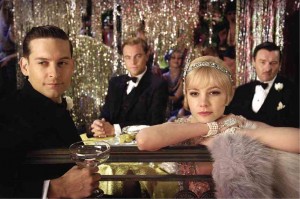
STUNNING visuals compromise the performance of actors (from left) Tobey Maguire, Leonardo DiCaprio, Carey Mulligan and Joel Edgerton in “The Great Gatsby.”
We were looking forward to watching Baz Luhrmann’s idiosyncratic take on F. Scott Fitzgerald’s “The Great Gatsby” because, at first blush, the two artistic entities appear to be meant for each other.
“Gatsby” chronicles the Roaring Twenties and its extravagant excesses before the Great Depression sent the United States stock exchange hurtling down to tragic oblivion, dragging many self-made fortunes to their flaming deaths.
“Copacetically,” Luhrmann is acclaimed for his orgiastic visual feasts for the cinema, like “Moulin Rouge” and “Romeo + Juliet.”
If they got “married,” what a brilliantly viewable cinematic child they would beget!
True enough, as we watch the first half of Luhrmann’s “Gatsby” memorably unreel, one visual tour de force follows another in a seemingly unending bacchanal for all of the senses.
Demented determination
Hundreds of frenzied carousers fill the movie’s big scenes with their heaving bodies, dancing feet, flailing limbs and demented determination to live life to the fullest, and keep the “never-ending” night from anticlimactically turning into sallow, callow day!
At the center of all this urgent carousing is the big party’s mysterious host, played by Leonardo DiCaprio. All sorts of contradictory rumors roil and rage around his person and persona, but his gate-crashing guests don’t care, as long as he wines and dines them nightly into soporific submission.
But, a few key characters do care, including Daisy Buchanan (played by Carey Mulligan), the “firefly” beauty he loved and lost five years ago—and now wants to possess again, despite the fact that she’s married to another wealthy man (portrayed by Joel Edgerton).
Also an interested observer who gets sucked into the film’s accelerating dramatic crisis and cathartic denouement is Nick Carraway (Tobey Maguire).
These principal players “dance” around and lunge at each other even as the film’s larger crowd of carousers magnify the eventual horror of their shared tragedy.
Unfortunately for the film, however, Luhrmann spends so much time making his “celebratory” visuals so stunningly and perfervidly memorable that, when the harsh light of day disperses Gatsby’s “roaring” carousers, the story’s “core” drama turns out to be disappointingly small and shallow.
Most tragic victim
Yes, Gatsby and his muse love one another with uncommon passion, but it can’t match the impact of the visual bacchanal that has preceded it—which was supposed to merely provide a clarifying context to the love story’s real drama, but ends up running away with the show!
The film’s most tragic victim is lead actor DiCaprio, whose character has been rendered so perplexingly unfocused and dramatically inutile that even the gifted actor’s best efforts can’t make him a flesh-and-blood person.
This is a major downer because, in his past cinematic confections, especially “Romeo + Juliet” (which ironically also starred DiCaprio), Luhrmann succeeded in getting his visual kicks and kinks in without compromising his lead players’ characterizations.
Alas, this time around, the filmmaker fails to get the admittedly dodgy mix just right, so his whole cinematic creation tumbles around him and us—like a house of luckless, pluckless cards predicting ill fortune all the way.